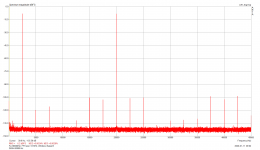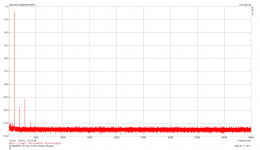Funny how waving one's arms around can sometimes look like swimming even as one sinks to the bottom.
Let us talk about intermodulation distortion. Often tested at 19,000 & 20,000 hertz test signals. It is almost always well below 1% for decent gear.
What happens if we use test signals of 20,000 and 2,500 hertz? Will the level of distortion change?
What happens if we use test signals of 20,000 and 2,500 hertz? Will the level of distortion change?
Let us talk about intermodulation distortion. Often tested at 19,000 & 20,000 hertz test signals. It is almost always well below 1% for decent gear.
What happens if we use test signals of 20,000 and 2,500 hertz? Will the level of distortion change?
Very hard to define a rule, it all depends on how the amplifier is handling the intermodulation products, that is, the loop gain available to line arise the amplifier at the intermodulation products frequencies. But I think a fair answer is yes, the IMD as a number may change, compared to the standard 19+20KHz. Likely for good, since most of the high order intermodulation products are at lower frequencies.
IM distortion testing got popular with magnetic tape. The usual IMD analyzers used 60Hz and 7KHz, mixed 4:1 (from memory, quite possibly wrong) and 19/20KHz would have been considered brutal, even for just the electronics, of the day. But of course you know all that; why ask? I hope it doesn't involve "modulation".
Always the best,
Chris
Always the best,
Chris
Yah...I be down for a while..things at do.
Jn
OK. Me too. Got lots to do. Thank you for the stimulating discussion. Great stuff 🙂
I will also leave the zoo to the animals here to fight amongst themselves.
Have a great year. Great 10 years. You are lucky to be working with great minds... original creative thinkers.
THx-Richard
Last edited:
Let us talk about intermodulation distortion. Often tested at 19,000 & 20,000 hertz test signals. It is almost always well below 1% for decent gear.
What happens if we use test signals of 20,000 and 2,500 hertz? Will the level of distortion change?
Hi Ed, attached, for this DUT your proposed test is more severe.
Attachments
Last edited:
Tried cymbal samples and got 9/10
Poll: Cymbals of different sampling rates listening test
BTW, I have a new opamp listening test as well.
Poll: Cymbals of different sampling rates listening test
BTW, I have a new opamp listening test as well.
Tried cymbal samples and got 9/10
Poll: Cymbals of different sampling rates listening test
BTW, I have a new opamp listening test as well.
Interesting result.
Do you have any possible explanation for this, and was your test performed with speakers, with headphones or some other means?
What I did’n fully understand from UT’s explanation, were the test files made with lossy or lossless files, the term MP3 confused me in that respect.
Hans
Interesting result.
Do you have any possible explanation for this, and was your test performed with speakers, with headphones or some other means?
What I did’n fully understand from UT’s explanation, were the test files made with lossy or lossless files, the term MP3 confused me in that respect.
Hans
Hi Hans, I listened through Sennheiser HD598 driven from my Audio Buffer headphone amplifier (please scroll down in the linked page)
Audio Buffer in english
I found extremely important to drive HD598 from close to zero output impedance, otherwise their frequency response is modulated by their impedance/frequency characteristics and the sound becomes muddy, inaccurate and with worse resolution. I was surprised how big difference it makes to drive HD598 from almost zero impedance (0.056 ohm in my case).
I am not sure how UT prepared the frequency limited file. Both files are in 176kHz sample rate, probably A1 was made from A2 by 320kbps mp3, then converted to wav and upsampled to 176kHz, so A1 and A2 have same data format.
@UT
I do read all sorts of formats, in your poll: mp3, mp4, 44.1/16, 176,4 and 320kbs.
Could you please tell step by step where you started and how you made from there the “resampled” and the “original” files.
And was any lossy step made in between ?
Hans
I do read all sorts of formats, in your poll: mp3, mp4, 44.1/16, 176,4 and 320kbs.
Could you please tell step by step where you started and how you made from there the “resampled” and the “original” files.
And was any lossy step made in between ?
Hans
@UT
I do read all sorts of formats, in your poll: mp3, mp4, 44.1/16, 176,4 and 320kbs.
Could you please tell step by step where you started and how you made from there the “resampled” and the “original” files.
And was any lossy step made in between ?
Hans
I read it that the original was converted to mp3, then those were converted to the two files we listened to for each of A, B, and C.
mp3 uses a lossy “psychoacoustic” compression, whatever that may do precisely.I read it that the original was converted to mp3, then those were converted to the two files we listened to for each of A, B, and C.
In the light of the ongoing discussion, 44.1/16 vs 96/24, this is something that I don’t think to be the right intermediate step.
Hans
We should stop now we are waking the lurkers.
Just waiting for you guys to come up for air so we can move on to the next ‘re-discussion’ topic 😀
We’ve beaten this DAC/ADC thing to death on this thread. This the 3rd or 4th cycle IIRC.
What subject can we return to discuss? Feedback? SMD vs leaded? Silver solder vs lead/tin? Or what about that old chestnut feedback vs no feedback? CFA vs VFA? Teflon PCB vs FR4? Or my favorite - why NPO/COG causes constrained sound compared to film capacitors . . .
Yes, going thru mp3 is "brutal", which makes the poll results even more surprising. I can only come to two conclusions in regard to this test:mp3 uses a lossy “psychoacoustic” compression, whatever that may do precisely.
In the light of the ongoing discussion, 44.1/16 vs 96/24, this is something that I don’t think to be the right intermediate step.
Hans
1. Some of the participants maybe listened to files on "less than ideal" equipment - i.e. computer, "all in one" receiver etc.
2. Sound samples were too short and consisted of only one single crash. That can drive anyone nuts and fatigue sets in quite early. (Those with experience in recording studio or in composing songs using sampled sounds will understand what I mean).
Some short musical passage could have been much better.
P.S. Hans, here's an open source audio editing/analysis software that might suit your needs. No need to deal with all that Adobe nonsense 😉
Audacity (R) | Free, open source, cross-platform audio software for multi-track recording and editing.
And here's one filter plug-in (two versions, actually) that you might find useful as well:
Windowed-sinc filter (steep cut-off filter) - Audacity Forum
Thank you.P.S. Hans, here's an open source audio editing/analysis software that might suit your needs. No need to deal with all that Adobe nonsense 😉
Audacity (R) | Free, open source, cross-platform audio software for multi-track recording and editing.
And here's one filter plug-in (two versions, actually) that you might find useful as well:
Windowed-sinc filter (steep cut-off filter) - Audacity Forum
I have Audacity, but the spectra it produces are very weird.
But for copy/cut of .wav files or analyzing .wav files in the time domain, it’s very useful. And maybe the steep filter you mentioned is a bonus.
I’ll give it a try.
Hans
What subject can we return to discuss? Feedback? SMD vs leaded? Silver solder vs lead/tin? Or what about that old chestnut feedback vs no feedback? CFA vs VFA? Teflon PCB vs FR4? Or my favorite - why NPO/COG causes constrained sound compared to film capacitors . . .
Goop®
Hans, he renamed wav to mp4 to be able to put them as attachments. You need to read the thread and to do some job yourself to find answers, it is much more effective way than to discuss. Applies to almost anyone here. Discussions after some 2 exchanges of opinions become useless.
Here's another very useful freebee:Thank you.
I have Audacity, but the spectra it produces are very weird.
But for copy/cut of .wav files or analyzing .wav files in the time domain, it’s very useful. And maybe the steep filter you mentioned is a bonus.
I’ll give it a try.
Hans
Free Spectrum Analyzer Plugin, FFT, Real-Time [VST, AU, AAX] - SPAN | Voxengo
- Status
- Not open for further replies.
- Home
- Member Areas
- The Lounge
- John Curl's Blowtorch preamplifier part III


